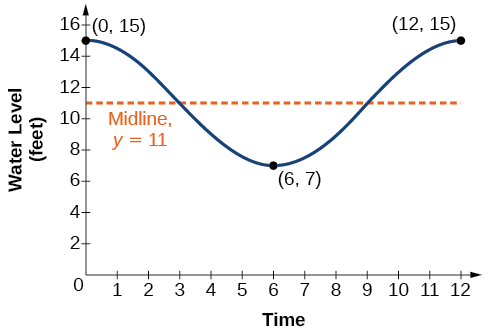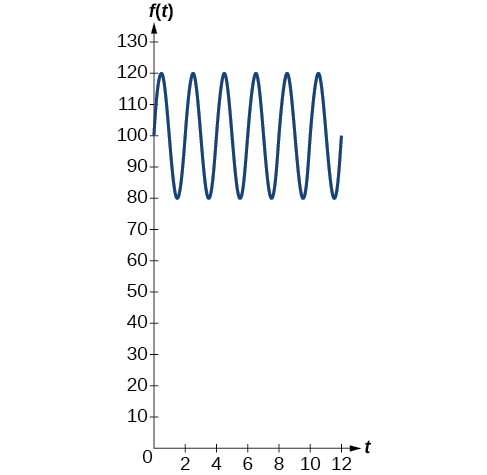| << Chapter < Page | Chapter >> Page > |
The hour hand of the large clock on the wall in Union Station measures 24 inches in length. At noon, the tip of the hour hand is 30 inches from the ceiling. At 3 PM, the tip is 54 inches from the ceiling, and at 6 PM, 78 inches. At 9 PM, it is again 54 inches from the ceiling, and at midnight, the tip of the hour hand returns to its original position 30 inches from the ceiling. Let equal the distance from the tip of the hour hand to the ceiling hours after noon. Find the equation that models the motion of the clock and sketch the graph.
Begin by making a table of values as shown in [link] .
| Points to plot | ||
|---|---|---|
| Noon | 30 in | |
| 3 PM | 54 in | |
| 6 PM | 78 in | |
| 9 PM | 54 in | |
| Midnight | 30 in |
To model an equation, we first need to find the amplitude.
The clock’s cycle repeats every 12 hours. Thus,
The vertical shift is
There is no horizontal shift, so Since the function begins with the minimum value of when (as opposed to the maximum value), we will use the cosine function with the negative value for In the form the equation is
See [link] .

The height of the tide in a small beach town is measured along a seawall. Water levels oscillate between 7 feet at low tide and 15 feet at high tide. On a particular day, low tide occurred at 6 AM and high tide occurred at noon. Approximately every 12 hours, the cycle repeats. Find an equation to model the water levels.
As the water level varies from 7 ft to 15 ft, we can calculate the amplitude as
The cycle repeats every 12 hours; therefore, is
There is a vertical translation of Since the value of the function is at a maximum at we will use the cosine function, with the positive value for
See [link] .

The daily temperature in the month of March in a certain city varies from a low of to a high of Find a sinusoidal function to model daily temperature and sketch the graph. Approximate the time when the temperature reaches the freezing point Let correspond to noon.
The temperature reaches freezing at noon and at midnight.

The average person’s blood pressure is modeled by the function where represents the blood pressure at time measured in minutes. Interpret the function in terms of period and frequency. Sketch the graph and find the blood pressure reading.
The period is given by
In a blood pressure function, frequency represents the number of heart beats per minute. Frequency is the reciprocal of period and is given by
See the graph in [link] .

Harmonic motion is a form of periodic motion, but there are factors to consider that differentiate the two types. While general periodic motion applications cycle through their periods with no outside interference, harmonic motion requires a restoring force. Examples of harmonic motion include springs, gravitational force, and magnetic force.

Notification Switch
Would you like to follow the 'Precalculus' conversation and receive update notifications?